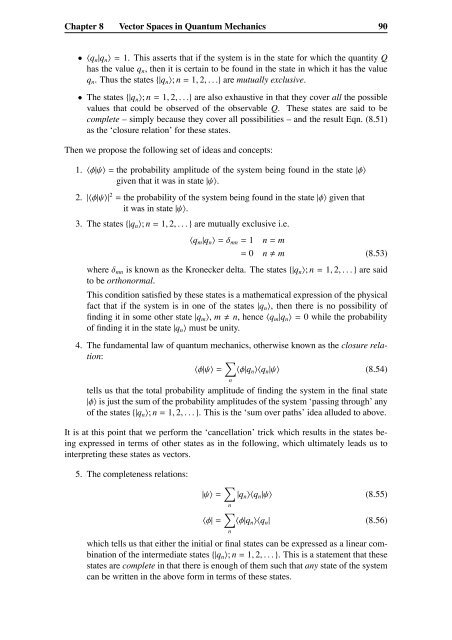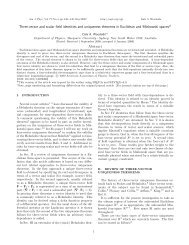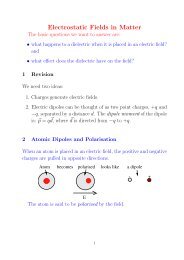Chapter 8 Vector Spaces in Quantum Mechanics
Chapter 8 Vector Spaces in Quantum Mechanics
Chapter 8 Vector Spaces in Quantum Mechanics
You also want an ePaper? Increase the reach of your titles
YUMPU automatically turns print PDFs into web optimized ePapers that Google loves.
<strong>Chapter</strong> 8 <strong>Vector</strong> <strong>Spaces</strong> <strong>in</strong> <strong>Quantum</strong> <strong>Mechanics</strong> 90• 〈q n |q n 〉 = 1. This asserts that if the system is <strong>in</strong> the state for which the quantity Qhas the value q n , then it is certa<strong>in</strong> to be found <strong>in</strong> the state <strong>in</strong> which it has the valueq n . Thus the states {|q n 〉; n = 1, 2, . . .} are mutually exclusive.• The states {|q n 〉; n = 1, 2, . . .} are also exhaustive <strong>in</strong> that they cover all the possiblevalues that could be observed of the observable Q. These states are said to becomplete – simply because they cover all possibilities – and the result Eqn. (8.51)as the ‘closure relation’ for these states.Then we propose the follow<strong>in</strong>g set of ideas and concepts:1. 〈φ|ψ〉 = the probability amplitude of the system be<strong>in</strong>g found <strong>in</strong> the state |φ〉given that it was <strong>in</strong> state |ψ〉.2. |〈φ|ψ〉| 2 = the probability of the system be<strong>in</strong>g found <strong>in</strong> the state |φ〉 given thatit was <strong>in</strong> state |ψ〉.3. The states {|q n 〉; n = 1, 2, . . . } are mutually exclusive i.e.〈q m |q n 〉 = δ mn = 1 n = m= 0 n m (8.53)where δ mn is known as the Kronecker delta. The states {|q n 〉; n = 1, 2, . . . } are saidto be orthonormal.This condition satisfied by these states is a mathematical expression of the physicalfact that if the system is <strong>in</strong> one of the states |q n 〉, then there is no possibility off<strong>in</strong>d<strong>in</strong>g it <strong>in</strong> some other state |q m 〉, m n, hence 〈q m |q n 〉 = 0 while the probabilityof f<strong>in</strong>d<strong>in</strong>g it <strong>in</strong> the state |q n 〉 must be unity.4. The fundamental law of quantum mechanics, otherwise known as the closure relation:∑〈φ|ψ〉 = 〈φ|q n 〉〈q n |ψ〉 (8.54)ntells us that the total probability amplitude of f<strong>in</strong>d<strong>in</strong>g the system <strong>in</strong> the f<strong>in</strong>al state|φ〉 is just the sum of the probability amplitudes of the system ‘pass<strong>in</strong>g through’ anyof the states {|q n 〉; n = 1, 2, . . . }. This is the ‘sum over paths’ idea alluded to above.It is at this po<strong>in</strong>t that we perform the ‘cancellation’ trick which results <strong>in</strong> the states be<strong>in</strong>gexpressed <strong>in</strong> terms of other states as <strong>in</strong> the follow<strong>in</strong>g, which ultimately leads us to<strong>in</strong>terpret<strong>in</strong>g these states as vectors.5. The completeness relations:∑|ψ〉 = |q n 〉〈q n |ψ〉 (8.55)n∑〈φ| = 〈φ|q n 〉〈q n | (8.56)nwhich tells us that either the <strong>in</strong>itial or f<strong>in</strong>al states can be expressed as a l<strong>in</strong>ear comb<strong>in</strong>ationof the <strong>in</strong>termediate states {|q n 〉; n = 1, 2, . . . }. This is a statement that thesestates are complete <strong>in</strong> that there is enough of them such that any state of the systemcan be written <strong>in</strong> the above form <strong>in</strong> terms of these states.
















